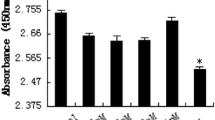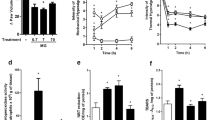Abstract
Evodiamine (EVO), an important alkaloidal component extracted from the fruit of Evodiae fructus, has been known to possess anti-tumor, anti-inflammatory, anti-oxidative, and other therapeutic capabilities. In the present study, the effects of EVO on zymosan-induced inflammation and its underlying mechanism were investigated both in vitro and in vivo. Our results showed that EVO effectively suppressed both protein and mRNA expression of interleukin-1β, interleukin-6 (IL-6), and tumor necrosis factor-α (TNF-α) in vitro. Zymosan-induced DNA-binding activity of nuclear factor-kappa B (NF-κB) was attenuated by EVO, which was achieved through inhibitory effects on the phosphorylation of inhibitory κB α and p65 nuclear translocation, but there was very little association with mitogen-activated protein kinase activation. In vivo, treatment with EVO markedly decreased TNF-α and IL-6 levels in plasma. EVO also repressed inflammatory cytokine expression and ameliorated the abnormal state in both lung and intestine tissues by inactivation of NF-κB. Furthermore, EVO significantly reduced the mortality caused by zymosan. In summary, these results suggested that EVO could effectively suppress inflammatory responses in vitro and in vivo, and may be a potential therapeutic agent against inflammatory disorders.










Similar content being viewed by others

References
Seely, A.J., and N.V. Christou. 2000. Multiple organ dysfunction syndrome: exploring the paradigm of complex nonlinear systems. Critical Care Medicine 28 (7): 2193–2200.
Jia, W., L. Cao, S. Yang, H. Dong, Y. Zhang, H. Wei, W. Jing, L. Hou, and C. Wang. 2013. Regulatory T cells are protective in systemic inflammation response syndrome induced by zymosan in mice. PloS One 8 (5): e64397. doi:10.1371/journal.pone.0064397.
Medzhitov, R. 2008. Origin and physiological roles of inflammation. Nature 454 (7203): 428–435.
Nathan, C. 2002. Points of control in inflammation. Nature 420 (6917): 846–852.
Serhan, C.N., and J. Savill. 2005. Resolution of inflammation: the beginning programs the end. Nature Immunology 6 (12): 1191–1197.
Fizpatrick, F.W., and F.J. DiCarlo. 1964. Zymosan. Annals of the New York Academy of Sciences 118 (4): 235–261.
Volman, T.J., T. Hendriks, and R.J. Goris. 2005. Zymosan-induced generalized inflammation: experimental studies into mechanisms leading to multiple organ dysfunction syndrome. Shock 23 (4): 291–297.
Takeuchi, O., and S. Akira. 2001. Toll-like receptors; their physiological role and signal transduction system. International Immunopharmacology 1 (4): 625–635.
Di, R., M.T. Huang, and C.T. Ho. 2011. Anti-inflammatory activities of mogrosides from Momordica grosvenori in murine macrophages and a murine ear edema model. Journal of Agricultural and Food Chemistry 59 (13): 7474–7481.
Chung, W.Y., J.H. Park, M.J. Kim, H.O. Kim, J.K. Hwang, S.K. Lee, and K.K. Park. 2007. Xanthorrhizol inhibits 12-O-tetradecanoylphorbol-13-acetate-induced acute inflammation and two-stage mouse skin carcinogenesis by blocking the expression of ornithine decarboxylase, cyclooxygenase-2 and inducible nitric oxide synthase through mitogen-activated protein kinases and/or the nuclear factor-kB. Carcinogenesis 28 (6): 1224–1231.
Ho, Y.S., C.S. Lai, H.I. Liu, S.Y. Ho, C. Tai, M.H. Pan, and Y.J. Wang. 2007. Dihydrolipoic acid inhibits skin tumor promotion through anti-inflammation and anti-oxidation. Biochemical Pharmacology 73 (11): 1786–1795.
Folmer, F., M. Jaspars, M. Dicato, and M. Diederich. 2008. Marine natural products as targeted modulators of the transcription factor NF-kB. Biochemical Pharmacology 75 (3): 603–617.
Kasinski, A.L., Y. Du, S.L. Thomas, J. Zhao, S.Y. Sun, F.R. Khuri, C.Y. Wang, et al. 2008. Inhibition of IkappaB kinase-nuclear factor-kappaB signaling pathway by 3,5-bis(2-flurobenzylidene)piperidin-4-one (EF24), a novel monoketone analog of curcumin. Molecular Pharmacology 74 (3): 654–661.
Hayden, M.S., and S. Ghosh. 2004. Signaling to NF-kappaB. Genes & Development 18 (18): 2195–2224.
Yaron, A., A. Hatzubai, M. Davis, I. Lavon, S. Amit, A.M. Manning, J.S. Andersen, M. Mann, F. Mercurio, and Y. Ben-Neriah. 1998. Identification of the receptor component of the IkappaBalpha-ubiquitin ligase. Nature 396 (6711): 590–594.
Ghosh, S., and M.S. Hayden. 2008. New regulators of NF-kappaB in inflammation. Nature Reviews Immunology 8 (11): 837–848.
Banerjee, S., J.W. Zmijewski, E. Lorne, G. Liu, Y. Sha, and E. Abraham. 2010. Modulation of SCF beta-TrCP-dependent I kappaB alpha ubiquitination by hydrogen peroxide. Journal of Biological Chemistry 285 (4): 2665–2675.
Gao, X., X. Yang, and P.J. Marriott. 2012. Simultaneous analysis of seven alkaloids in Coptis–Evodia herb couple and Zuojin pill by UPLC with accelerated solvent extraction. Journal of Separation Science 33 (17, 18): 2714–2722.
Ogasawara, M., T. Matsunaga, S. Takahashi, I. Saiki, and H. Suzuki. 2002. Anti-invasive and metastatic activities of evodiamine. Biological and Pharmaceutical Bulletin 25 (11): 1491–1493.
Liu, Y.N., S.L. Pan, C.H. Liao, D.Y. Huang, J.H. Guh, C.Y. Peng, Y.L. Chang, and C.M. Teng. 2009. Evodiamine represses hypoxia-induced inflammatory proteins expression and hypoxia-inducible factor 1 [alpha] accumulation in RAW264.7. Shock 32 (3): 263–269.
Ko, H.C., Y.H. Wang, K.T. Liou, C.M. Chen, C.H. Chen, W.Y. Wang, S. Chang, Y.C. Hou, K.T. Chen, and C.F. Chen. 2007. Anti-inflammatory effects and mechanisms of the ethanol extract of Evodia rutaecarpa and its bioactive components on neutrophils and microglial cells. European Journal of Pharmacology 555 (2): 211–217.
Choi, Y.H., E.M. Shin, Y.S. Kim, X.F. Cai, J.J. Lee, and H.P. Kim. 2006. Anti-inflammatory principles from the fruits ofEvodia rutaecarpa and their cellular action mechanisms. Archives of Pharmacal Research 29 (4): 293–297.
Li, D.Q., N. Zhou, L. Zhang, P. Ma, and S.C. Pflugfelder. 2010. Suppressive effects of azithromycin on zymosan-induced production of proinflammatory mediators by human corneal epithelial cells. Investigative Ophthalmology and Visual Science 51 (11): 5623–5629.
Chiou, W.F., Y.J. Sung, J.F. Liao, A.Y. Shum, and C.F. Chen. 1997. Inhibitory effect of dehydroevodiamine and evodiamine on nitric oxide production in cultured murine macrophages. Journal of Natural Products 60 (7): 708–711.
Liu, Q.P., K. Fruit, J. Ward, and P.H. Correll. 1999. Negative regulation of macrophage activation in response to IFN-gamma and lipopolysaccharide by the STK/RON receptor tyrosine kinase. Journal of Immunology 163 (12): 6606–6613.
Ikeda, Y., Y. Adachi, K. Ishibashi, N. Miura, and N. Ohno. 2005. Activation of toll-like receptor-mediated NF-kappa beta by zymosan-derived water-soluble fraction: possible contribution of endotoxin-like substances. Immunopharmacology and Immunotoxicology 27 (2): 285–298.
Gupta, S.C., C. Sundaram, S. Reuter, and B.B. Aggarwal. 2010. Inhibiting NF-kappaB activation by small molecules as a therapeutic strategy. Biochimica et Biophysica Acta 1799 (10–12): 775–787.
Jung, W.K., D.Y. Lee, C. Park, Y.H. Choi, I. Choi, S.G. Park, S.K. Seo, et al. 2010. Cilostazol is anti-inflammatory in BV2 microglial cells by inactivating nuclear factor-kappaB and inhibiting mitogen-activated protein kinases. British Journal of Pharmacology 159 (6): 1274–1285.
Takada, Y., Y. Kobayashi, and B.B. Aggarwal. 2005. Evodiamine abolishes constitutive and inducible NF-kappaB activation by inhibiting IkappaBalpha kinase activation, thereby suppressing NF-kappaB-regulated antiapoptotic and metastatic gene expression, up-regulating apoptosis, and inhibiting invasion. Journal of Biological Chemistry 280 (17): 17203–17212.
Nomi, N., K. Kimura, and T. Nishida. 2010. Release of interleukins 6 and 8 induced by zymosan and mediated by MAP kinase and NF-kappaB signaling pathways in human corneal fibroblasts. Investigative Ophthalmology and Visual Science 51 (6): 2955–2959.
Friedland, J.S., D. Constantin, T.C. Shaw, and E. Stylianou. 2001. Regulation of interleukin-8 gene expression after phagocytosis of zymosan by human monocytic cells. Journal of Leukocyte Biology 70 (3): 447–454.
Carter, A.B., and G.W. Hunninghake. 2000. A constitute active MEK->ERK pathway negatively regulates NF-kappa B dependent gene expression by modulating TATA-binding protein phosphorylation. The Journal of Biological Chemistry 275 (36): 27858–27864.
Watzlawick, R., E.E. Kenngott, F.D. Liu, J.M. Schwab, and A. Hamann. 2015. Anti-inflammatory effects of IL-27 in zymosan-induced peritonitis: inhibition of neutrophil recruitment partially explained by impaired mobilization from bone marrow and reduced chemokine levels. PloS One 10 (9): 347–350.
Hernandez-Palazon, J., D. Fuentes-Garcia, S. Burguillos-Lopez, P. Domenech-Asensi, T.V. Sansano-Sanchez, and F. Acosta-Villegas. 2013. Analysis of organ failure and mortality in sepsis due to secondary peritonitis. Medicina Intensiva 37 (7): 461–467.
Hanisch, E., R. Brause, J. Paetz, and B. Arlt. 2011. Review of a large clinical series: predicting death for patients with abdominal septic shock. Journal of Intensive Care Medicine 26 (1): 27–33.
Davies, M.G., and P.O. Hagen. 1997. Systemic inflammatory response syndrome. British Journal of Surgery 84 (7): 920–935.
Schulte, W., J. Bernhagen, and R. Bucala. 2013. Cytokines in sepsis: potent immunoregulators and potential therapeutic target—an update view. Mediators of Inflammation 2013 (7): 165974.
Sharma, S., and A. Kumar. 2003. Septic shock, multiple organ failure, and acute respiratory distress syndrome. Current Opinion in Pulmonary Medicine 9 (3): 199–209.
Patel, B.V., M.R. Wilson, K.P. O'Dea, and M. Takata. 2013. TNF-induced death signaling triggers alveolar epithelial dysfunction in acute lung injury. Journal of Immunology 190 (8): 4274–4282.
Volman, T.J., T. Hendriks, A.A. Verhofstad, B.J. Kullberg, and R.J. Goris. 2002. Improved survival of TNF-deficient mice during the zymosan-induced multiple organ dysfunction syndrome. Shock 17 (6): 468–472.
Burdon, D., T. Tiedje, K. Pfeffer, E. Vollmer, and P. Zabel. 2000. The role of tumor necrosis factor in the development of multiple organ failure in a murine model. Critical Care Medicine 28 (6): 1962–1967.
Jansen, M.J., T. Hendriks, R. Hermsen, J.W.M.V.D. Meer, and R.J.A. Goris. 1998. A monoclonal antibody against tumour necrosis factor-a improves survival in experimental multiple organ dysfunction syndrome. Cytokine 10 (11): 904–910.
Remick, D.G., G. Bolgos, S. Copeland, and J. Siddiqui. 2005. Role of interleukin-6 in mortality from and physiologic response to sepsis. Infection and Immunity 73 (5): 2751–2757.
Riedemann, N.C., T.A. Neff, R.F. Guo, K.D. Bernacki, I.J. Laudes, J.V. Sarma, J.D. Lambris, and P.A. Ward. 2003. Protective effects of IL-6 blockade in sepsis are linked to reduced C5a receptor expression. The Journal of Immunology 170 (1): 503–507.
Ohmoto, K., and S. Yamamoto. 2005. Serum interleukin-6 and interleukin-10 in patients with acute pancreatitis: clinical implications. Hepato-Gastroenterology 52 (64): 990–994.
Pooran, N., A. Indaram, P. Singh, and S. Bank. 2003. Cytokines (IL-6, IL-8, TNF): early and reliable predictors of severe acute pancreatitis. Journal of Clinical Gastroenterology 37 (3): 263–266.
Falvo, J.V., A.V. Tsytsykova, and A.E. Goldfeld. 2010. Transcriptional control of the TNF gene. Current Directions in Autoimmunity 11: 27–60.
Tsai, E.Y., J. Yie, D. Thanos, and A.E. Goldfeld. 1996. Cell-type-specific regulation of the human tumor necrosis factor alpha gene in B cells and T cells by NFATp and ATF-2/JUN. Molecular & Cellular Biology 16 (10): 5232–5244.
Acknowledgments
This work was supported by grants from the National Natural Science Foundation of China (NSFC, no. 81372088, 81671906) and National Major Scientific and Technological Special Project for “Significant New Drugs Development” (2014ZX09J14107-08C).
Author information
Authors and Affiliations
Corresponding author
Ethics declarations
Conflict of Interest
The authors declare that they have no conflicts of interest.
Additional information
X.F. and J.-Y.Z. contributed equally in this research.
Rights and permissions
About this article
Cite this article
Fan, X., Zhu, JY., Sun, Y. et al. Evodiamine Inhibits Zymosan-Induced Inflammation In Vitro and In Vivo: Inactivation of NF-κB by Inhibiting IκBα Phosphorylation. Inflammation 40, 1012–1027 (2017). https://doi.org/10.1007/s10753-017-0546-0
Published:
Issue Date:
DOI: https://doi.org/10.1007/s10753-017-0546-0



